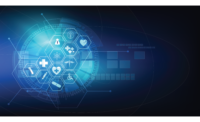Reopening businesses and schools safely and successfully utilizing security technology

As businesses and schools seek to bring people back to brick and mortar establishments, it’s going to be important to make customers, students and teachers feel comfortable, in addition to simply following guidelines. Customers are going to have to feel that it’s worth going out, versus shopping on-line. For retailers, that comfort might in part be derived from visible occupancy monitoring efforts and automated voice-down messages when people aren’t wearing masks or keeping their distance.
We’ve seen how some businesses have closed all entrances but one and stationed employees outside the store to screen and count customers wishing to come inside. It’s a costly use of employee resource, it risks confrontation, the counting can be highly inaccurate, and it doesn’t exactly welcome people with open arms. Banks, many of which offer online services, have even less traffic, so having an employee screening the few people who still require walk-in services is a poor use of their limited resources. Having multiple entrances at the premises only compounds the problem.
Schools are particularly challenging, since the density of students in any particular area can be hard to manage. It could be easy to overload any mask detection system, which could result in continuous voice alerts that eventually get ignored and not taken seriously by students and staff alike. Successfully using technology to help enforce guidelines has to be well-thought-out and can only be only one part of a comprehensive plan for K-12 and higher education.
How can security technology be used to help brick and mortar establishments reopen successfully?
Many businesses already have security cameras installed. They are generally accepted and unintrusive for patrons. Depending on how new they are and who made them, existing cameras may be capable of installing apps that can detect if face masks are being worn or not. The latest artificial intelligence (AI)-based cameras can detect masks and count people entering and exiting premises from multiple entry points. They can drive displays and play messages to proactively inform customers and students about current occupancy levels and whether they should enter or wait. This frees staff from screening and counting duties, and most importantly, it reduces friction between employees and customers concerning policy compliance. Having a ‘voice from above’ asking people to wear a mask helps to remove the burden from staff. At minimum, it provides an alternative focus for any customer frustration.
There is plenty of interest in cameras that measure body temperature. There’s nothing wrong with monitoring temperatures and informing people if they are elevated. That can add to the “feel-good factor” where organizations are seen to be doing their best to help keep environments safe.
Smart tech investments should pay dividends in a post-pandemic world
With businesses and schools struggling to allocate their limited budgets responsibly, it’s imperative that any expenses serve their long-term needs. Whenever possible, technology investments should support multiple uses. After the immediate threat from COVID-19 is gone, cameras and supporting infrastructure can continue to evolve to support operations and business intelligence needs beyond pure surveillance. Modern IP-based cameras offer much more than simply recording video.
These comprehensive Internet of Things (IoT) sensors, coupled with a capable video management system (VMS), can be used to measure and analyze buying patterns and operations flow. They can be tied to point of sale (POS) systems and marketing tools. They are continually evolving to be an indispensable part of operational intelligence for any organization. Like our smartphones, apps can be developed to address specific needs when they arise. When the next pandemic rears its ugly head, these devices can be ready to adapt by providing touchless access for staff and again reminding people of their responsibilities. They may even help with contact tracing by generating reports about exposure to people who have become ill.
As the saying goes, necessity is the mother of invention. And as bad as this pandemic has been, it’s important to remember that some good tools have come out of it that will help businesses and schools as get back to some semblance of normalcy in the months ahead.
Looking for a reprint of this article?
From high-res PDFs to custom plaques, order your copy today!






